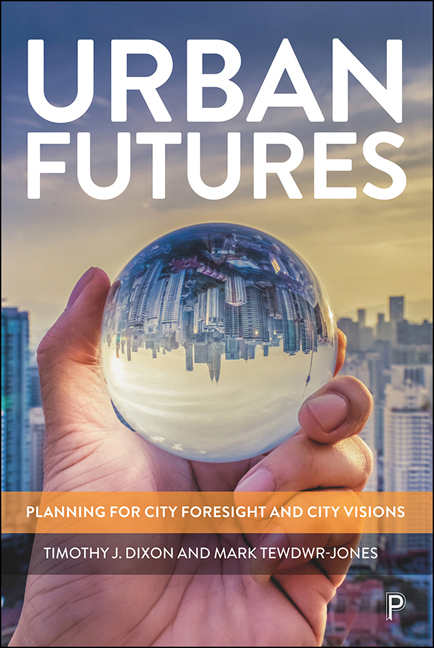Book contents
- Frontmatter
- Contents
- List of figures, tables and boxes
- Acknowledgements
- Foreword
- Preface
- 1 Urban futures: planning for city foresight and city visions
- 2 Cities and integrated urban challenges
- 3 Reimagining the city: views of the future from the past and present
- 4 Planning and governing the future city
- 5 Future narratives for the city: smart and sustainable?
- 6 Theoretical approaches to urban futures
- 7 Using city foresight methods to develop city visions
- 8 Shaping the future: city vision case studies
- 9 The innovative and experimental city
- 10 Visioning and planning the city in an urban age: a reality check
- 11 Conclusions: facing the urban future to 2050 and beyond
- Appendix: selected examples of city visions
- Notes
- References
- Index
1 - Urban futures: planning for city foresight and city visions
Published online by Cambridge University Press: 21 December 2021
- Frontmatter
- Contents
- List of figures, tables and boxes
- Acknowledgements
- Foreword
- Preface
- 1 Urban futures: planning for city foresight and city visions
- 2 Cities and integrated urban challenges
- 3 Reimagining the city: views of the future from the past and present
- 4 Planning and governing the future city
- 5 Future narratives for the city: smart and sustainable?
- 6 Theoretical approaches to urban futures
- 7 Using city foresight methods to develop city visions
- 8 Shaping the future: city vision case studies
- 9 The innovative and experimental city
- 10 Visioning and planning the city in an urban age: a reality check
- 11 Conclusions: facing the urban future to 2050 and beyond
- Appendix: selected examples of city visions
- Notes
- References
- Index
Summary
Introduction
Throughout history, and in times of continuing uncertainty, writers, artists, film-makers and others have attempted to make sense of the future. Some have argued that, by its very nature, the future is unknowable and unpredictable, whereas others have argued that by taking control of our destiny, and by ‘inventing’ the future, we can also play an important role in helping to create it. Today, as we stand on the cusp of what many consider to be a future that will present us with our greatest set of perennial challenges, we need more than ever to make sense of what the future holds for humanity. However, living in uncertain times, in an Anthropocene and in an ‘urban age’, where climate change, environmental impacts, health impacts, political turmoil and socioeconomic upheaval create potentially traumatic perils for both humanity and the natural world (Attenborough, 2020) , it is very difficult to even begin to see what the combined impacts of these forces might be, even in the short term, let alone the medium term (10–20 years) and long term (more than 20 years).
What is clear, however, is that, just as cities form the basis of many people's lives today, in all probability, they will also do in the future. Today, some 55 per cent of the world's population live in ‘urban settlements’ – as defined by the United Nations (UN) – and, by 2030, this will grow to 60 per cent, with one in every three people living in cities of at least half a million inhabitants, and, by 2050, that figure will be 70 per cent (UN, 2018a, 2018b). In some countries, the figure is already higher than this: in England and Wales, for example, 95 per cent of people live in built-up areas (or urban areas) (ONS, 2013). Cities, after all, act as engine houses for wealth creation, employment and human progress, by combining the forces of agglomeration and industrialisation (UN Habitat, 2016). For example, 80 per cent of global Gross Domestic Product (GDP) is generated in cities (World Bank, 2019). On the other hand, rapidly growing cities, particularly in the face of unrelenting globalisation and rapid technological change, can create urban sprawl, slums and areas of poverty and inequality, as well as environmental impacts through resource consumption and climate change.
- Type
- Chapter
- Information
- Urban FuturesPlanning for City Foresight and City Visions, pp. 1 - 16Publisher: Bristol University PressPrint publication year: 2021



